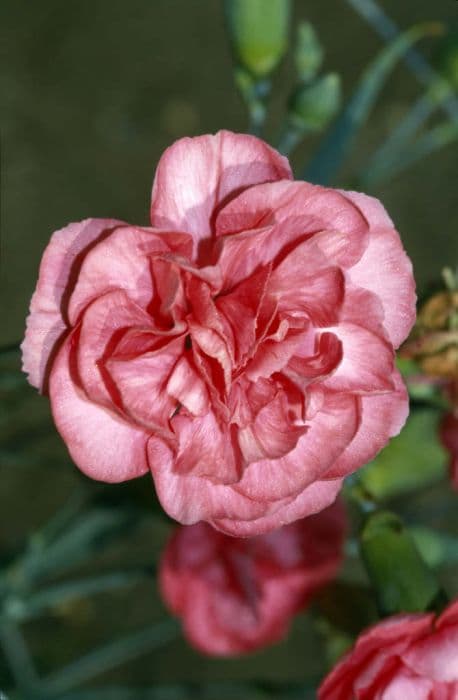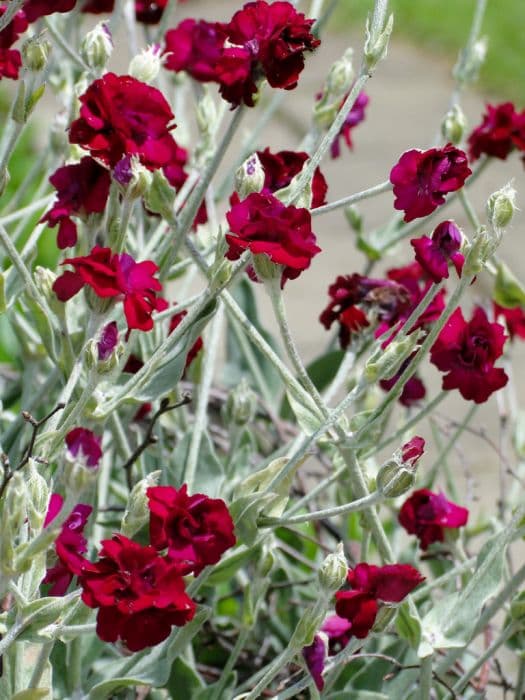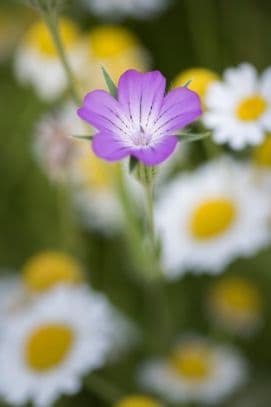Snow-in-Summer Cerastium tomentosum

ABOUT
The plant commonly known as Snow-in-Summer is a charming groundcover featuring velvety, silver-gray foliage that creates a striking contrast against other greens in the garden. This evergreen perennial is a visual delight not only for its foliage but also for its abundant, small white flowers that give it its common name. These star-shaped blossoms burst forth in late spring or early summer, blanketing the plant in a resemblance to a snowfall during the warmer months. The leaves are oblong to lance-shaped, and their woolly texture adds to the softness of the plant's overall appearance. Snow-in-Summer typically spreads outward with a mat-forming habit, making it a popular choice for rock gardens, borders, and as a filler between stepping-stones where it can create a lush, continuous carpet of silver and white. Its resilience, combined with the attractive colors and textures, make it a favored option for gardeners looking to add long-lasting visual interest without the need for tall or expansive plants.
About this plant
 Names
NamesFamily
Caryophyllaceae.
Synonyms
Snow-in-Summer, Mouse-Ear Chickweed, Silver Carpet, Snow Carpet, Woolly Mouse-Ear.
Common names
Cerastium biebersteinii, Cerastium tomentosum var. columnae, Cerastium tomentosum subsp. columnae.
 Toxicity
ToxicityTo humans
Snow-in-summer, Cerastium tomentosum, is generally considered non-toxic to humans. There is no well-documented evidence of toxicity upon ingestion, and it is not known to pose any significant health risk. Therefore, accidental consumption is unlikely to result in symptoms of poisoning or serious consequences.
To pets
Snow-in-summer, Cerastium tomentosum, is also generally considered non-toxic to pets. It is not known to contain any substances that are harmful to pets, so ingestion by animals such as dogs or cats should not result in any toxic effects or symptoms of poisoning.
 Characteristics
CharacteristicsLife cycle
Perennials
Foliage type
Evergreen
Color of leaves
Silvery-green
Flower color
White
Height
0.5 feet (15 cm)
Spread
1 foot (30 cm)
Plant type
Herb
Hardiness zones
3
Native area
Europe
Benefits
 General Benefits
General Benefits- Landscape beautification: Adds a splash of white with its star-shaped flowers, making it an attractive ground cover.
- Drought resistance: Once established, it is quite tolerant of dry conditions and requires minimal watering.
- Erosion control: Its spreading habit and dense growth can help stabilize soil on slopes or in areas prone to erosion.
- Low maintenance: Snow-in-summer typically requires little care beyond the occasional trimming back to encourage fresh growth.
- Pest resistance: Generally resistant to pests and diseases, which keeps garden maintenance low.
- Frost hardy: Capable of withstanding colder temperatures, making it suitable for cooler climates.
- Quick spreader: Covers garden areas quickly, providing a fast means to create a carpet of greenery and blooms.
- Wildlife attraction: Flowers can attract pollinators such as bees and butterflies, promoting biodiversity in the garden.
 Medical Properties
Medical PropertiesThis plant is not used for medical purposes.
 Air-purifying Qualities
Air-purifying QualitiesThis plant is not specifically known for air purifying qualities.
 Other Uses
Other Uses- Cerastium tomentosum, commonly known as Snow-in-Summer, can be used as a natural dye for fabrics, giving a light green tint when used with an alum mordant.
- It is often planted as a living mulch in gardens because its dense foliage can help suppress weeds and reduce soil moisture evaporation.
- Snow-in-Summer can be used in green roofing due to its drought-tolerance and ability to thrive in shallow soils, providing insulation and habitat for wildlife.
- This plant's silvery foliage can be a striking addition to floral arrangements, especially as a contrasting background for vibrant blooms.
- Gardeners may use the plant for its hardy nature to stabilize soil on slopes or embankments to prevent erosion.
- Snow-in-Summer can be used as a ground cover around stepping stones, as it can endure light foot traffic and softens the edges of the hardscape.
- In xeriscaping, the plant is valued for its very low water requirements once established, which can contribute to water conservation initiatives.
- The plant can act as an indicator species for overwatering; when Snow-in-Summer starts to decline, it may suggest that an area is being over-irrigated.
- During winter, when the plant is dormant, the contrasting white of its dead foliage against dark soil can add visual interest to otherwise barren gardens.
- Landscape designers might utilize Snow-in-Summer in moon gardens where its silvery leaves and white flowers reflect moonlight, creating a luminous night-time landscape feature.
Interesting Facts
 Feng Shui
Feng ShuiSnow in Summer is not used in Feng Shui practice.
 Zodiac Sign Compitability
Zodiac Sign CompitabilitySnow in Summer is not used in astrology practice.
 Plant Symbolism
Plant Symbolism- Innocence: Traditionally, Cerastium tomentosum, commonly known as Snow-in-Summer, features small, white flowers, which are often associated with purity and innocence.
- Tranquility: The plant's silvery foliage and delicate blossoms can evoke a sense of calm and peacefulness, symbolizing serenity.
- Adaptability: Snow-in-Summer is known for its ability to thrive in poor soil conditions, symbolizing resilience and the ability to adapt to challenging environments.
- Celebration: Its common name suggests a connection with the winter season, making it a symbol of festive joy and the celebration of cooler times during the warmth of the summer months.
 Water
WaterSnow-in-summer, commonly known as Cerastium tomentosum, prefers well-draining soil and should be watered thoroughly when the top inch of soil feels dry to the touch. An established plant typically needs watering once every week or two, depending on local weather conditions. During the active growing season in spring and summer, water the plant with about one gallon of water per plant, ensuring that the moisture reaches deep into the root zone. Reduce frequency of watering during the fall and winter when the plant is dormant. Always avoid overwatering to prevent root rot, a common issue with this species.
 Light
LightSnow-in-summer thrives in full sunlight, requiring at least 6 hours of direct sun per day. The ideal spot for this plant is in an area where it can bask in bright and unfiltered light throughout the day. However, it can endure light shade, especially in regions with extremely hot summers.
 Temperature
TemperatureSnow-in-summer can tolerate a wide range of temperatures, but it flourishes in conditions between 60 to 75°F. It is cold-hardy and can survive minimum temperatures down to around -30°F, making it suitable for USDA hardiness zones 3 through 7. For optimal growth, avoid exposing the plant to prolonged periods of heat above 80°F.
 Pruning
PruningPruning snow-in-summer is important to maintain its compact, mounded shape and to encourage healthy growth. Pruning should be done after the plant has finished flowering, usually in late summer or early fall. Cut back the plant by about one-third to one-half of its size to promote new growth and prevent it from becoming leggy. Pruning annually or as needed will also help rejuvenate the plant and maintain its appearance.
 Cleaning
CleaningAs needed
 Soil
SoilSnow-in-summer (Cerastium tomentosum) thrives in well-draining soil with a mix of loam, sand, and compost. For the best growth, maintain a slightly alkaline pH of around 6.0 to 7.5. A recipe suitable for this plant might be 60% loam, 30% sand, and 10% compost to ensure proper drainage and fertility.
 Repotting
RepottingSnow-in-summer does not typically require frequent repotting due to its spreading growth habit. This plant is often repotted or divided every 3 to 4 years to manage its size and rejuvenate the soil. Overcrowded clumps can be separated during repotting to encourage healthier growth.
 Humidity & Misting
Humidity & MistingSnow-in-summer prefers a relatively dry climate and is tolerant of low humidity levels. It does not necessitate high humidity and is quite adaptable to typical outdoor conditions where the humidity fluctuates naturally.
 Suitable locations
Suitable locationsIndoor
Grow Snow-in-summer in bright light in sandy, well-draining soil.
Outdoor
Plant Snow-in-summer in full sun, well-draining soil, and space adequately.
Hardiness zone
3-7 USDA
 Life cycle
Life cycleSnow-in-summer (Cerastium tomentosum) starts its life cycle as a seed which, when sown in spring or autumn, germinates in moist, well-drained soil. Seedlings emerge and develop into a low-growing, mat-forming perennial with silvery-grey foliage, given proper sunlight and temperature conditions. As the plant matures, it spreads out to form a ground cover, and by late spring to early summer, it reaches its flowering stage, displaying small, white, star-shaped flowers that attract pollinators such as bees and butterflies. After pollination, the flowers develop into small seed capsules, which release seeds when they mature, completing the reproductive cycle. Throughout the growing season, the plant continues to spread vegetatively through its roots and stolons, expanding its coverage area. Snow-in-summer enters a period of dormancy in the winter, with its above-ground parts dying back, but it will regrow from its root system when favorable conditions return in the spring.
 Propogation
PropogationPropogation time
Spring-Early Summer
Snow-in-Summer, scientifically known as Cerastium tomentosum, is most commonly propagated by division or cuttings. The ideal time to propagate this plant is in the spring or early fall when the temperature is mild and there is less risk of heat stress on the new plants. To propagate Snow-in-Summer by division, carefully dig up an established clump and gently separate it into smaller clumps, ensuring that each has a good root system and several shoots. These can then be replanted at the same depth they were growing at originally, spaced about 12 inches (roughly 30 centimeters) apart to allow for growth and air circulation. Water the newly planted divisions well and maintain consistent moisture until they are established.









